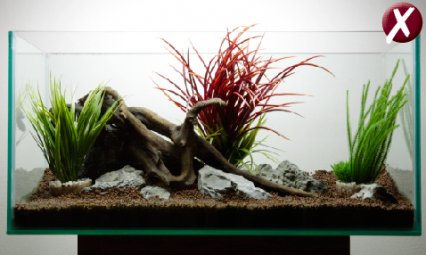George Farmer explains the basics of aquascaping your aquarium in a simple step-by-step lesson.
Keeping plants and décor in a tank may seem a simpler and easier proposition than catering for fish or inverts. You have far less to worry about and, if things go wrong, replacements should be a lot easier on the wallet.
However, anyone can make mistakes early on and such hitches may deter the newcomer from trying again in what should be a very rewarding hobby. Fear not. Here’s a guide to getting things right first time...
Substrate

1. A regular shaped aquarium is best. Bigger is generally better in terms of creative options and environmental stability, but smaller aquariums are less expensive to buy and maintain. This is a 60 x 30 x 30cm/ 24 x 12 x 12" tank.

2. I've added regular pea gravel which is fine for most circumstances, but can increase pH and hardness. Grain size is relatively large for this aquarium and ruins the sense of scale. The layer is too shallow to anchor any plants — even plastic ones.

3. This time I’ve added too much gravel. It looks unsightly and the excess depth may encourage a build-up of nasty substances such as toxic and foul-smelling hydrogen sulphide. It takes up valuable space that could be better utilised by water.

4. I’ve replaced the gravel with a soil-based substrate. Grain size is smaller, improving sense of scale. An attractive colour, it is sloped rearwards to add an illusion of depth. If I wish to add live plants later, this substrate is perfect as it contains lots of nutrients.
Wood

5. A lump of driftwood is added. The wood is suitably sized, but positioned incorrectly. The flat piece is clearly visible and looks unnatural. The right-hand branch is touching the glass, which would make cleaning difficult. The angle of the wood looks awkward too.

6. The wood is repositioned. It is moved off-centre to improve visual balance. The branches look more natural, as if they are coming out of the ground, like real tree roots. Real plants such as Java moss, Java fern and Anubias could be attached later.
Rocks

7. Five rocks are added. They look very odd, all standing vertically and in-line. The two rocks on the right are particularly distracting and immediately draw the eye — and all for the wrong reasons. Your eyes should move smoothly across an aquascape.

8. The rocks are re-positioned around the base of the driftwood. They are partially inserted into the substrate and carefully angled so they all follow a similar line leading into the wood. The idea is to make them look as natural as possible.
Plants

9. Three artificial plants are added. The red focal plant is placed slap bang in the centre, which is a classic mistake. The other two plants are added to the edges of the tank. The result is an aquascape that looks too symmetrical and aesthetically unbalanced.

10. The plants are re-arranged, colours and textures looking more natural, and the focal point is one-third across the aquarium length. This 'rule of thirds' is a classic compositional guide. The aquascape is now ready for water and fishless cycling before adding livestock.
Why not take out a subscription to Practical Fishkeeping magazine? See our latest subscription offer.







